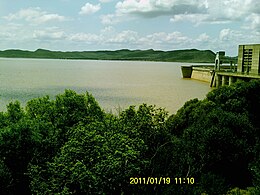| Gariep Dam | |
|---|---|
 | |
| Official name | Gariep Dam |
| Location | Border of Eastern Cape and Free State, South Africa |
| Coordinates | 30°37′25.43″S25°30′23.81″E / 30.6237306°S 25.5066139°E |
| Construction began | 1965 |
| Opening date | 1971 |
| Owner(s) | Department of Water Affairs |
| Dam and spillways | |
| Type of dam | Arch-gravity dam |
| Impounds | Orange River |
| Height | 88 m (289 ft) |
| Length | 914 m (2,999 ft) |
| Reservoir | |
| Creates | Gariep Dam Reservoir |
| Total capacity | 5,340,000 megalitres (5,340 hm3; 5.34×109 m3) [1] |
| Surface area | 374 km2 (144 sq mi) |
| Power Station | |
| Operator(s) | Eskom |
| Turbines | 4 x 90 MW (120,000 hp) |
| Installed capacity | 360 MW (480,000 hp) (max) |
| Annual generation | 889 GWh (3,200 TJ) [2] |
This article needs additional citations for verification .(July 2023) |
The Gariep Dam is located in South Africa, near the town of Norvalspont, bordering the Free State and Eastern Cape provinces. Its primary purpose is for irrigation, domestic and industrial use as well as for power generation. It the largest dam in South Africa.
Contents
- Name
- Location
- Dimensions
- Design type and contractors
- Gariep Dam Bridge
- Rivers and spruits flowing into the dam
- Water consumption, outflow, derivative usages and diversions
- Orange–Fish Water Scheme
- Orange-Fish River Tunnel
- Gariep hydroelectric power plant
- Gallery
- See also
- References
- External links
- Videos - Opening | Documentaries | Construction
- Videos - Aerial | Presentation
- Other








